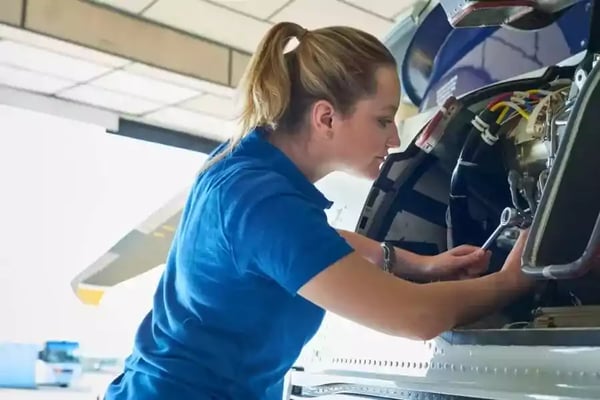Henrik Ollus asks why is it that, while the amount of data generated and recorded in aircraft operations has skyrocketed in the last few decades, the promised business benefits from the data have been slow to materialize.
THE POTENTIAL BENEFITS
The most impactful promises for what data utilization can deliver are extended component life and predictive maintenance. These have the potential for increasing the up-time of high-value assets and transitioning most unscheduled maintenance events to scheduled maintenance. They are made possible by the ever-increasing amount of data recorded by modern aircraft and AI-powered data analytics. Yet, the actual impact of implemented solutions to date has often fallen short of the expected benefits.
THE CHALLENGES
The main reason that the benefits are not achieved is that data management maturity for most airlines is low, and as with any data analytics applied, the quality of what you get out is determined by what you put in. Prerequisites for solutions offering extended life and predictive maintenance are high data quality and seamless data sharing between collaborating parties, e.g. original equipment manufacturers (OEMs) and airlines. To achieve full benefit from the solutions, additional data flows are required from the operators’ operative systems, such as the Maintenance & Engineering (M&E) system. The first challenge here is inadequate data quality. Paper-based maintenance process, manual data entry and sharing of records in .pdf format compromise data quality and cause delays in data entry.
The second challenge is the implementation of automated data exchange between the operator and OEM. The wide range of systems used within the industry results in a low level of standardization of data and data models across systems. For example, the M&E systems market is fragmented and there are multiple widely used systems, each with varying data models and integration capabilities.
THE SOLUTIONS
In many cases, the OEM can offer added value through analytics but expects the airline to independently implement data exchange and ensure high data quality. Some OEMs understand the challenges this poses for airlines and offer integration and data quality monitoring as a part of their leading-edge solutions. One good example is Rolls-Royce that, as a part of their Blue Data Thread Program, is rolling out an automated data exchange service for all their Trent-engine family customers. You can read more about Blue Data Thread in the case study: Rolls-Royce and QOCO; working together for PLM.
But what are the low hanging fruits for operators that cannot currently meet the prerequisites in data management maturity? There are many opportunities for airlines to improve their data quality as a part of other ongoing digitalization initiatives. For example, including a data quality working group as a part of the project in paperless initiatives ensures that underlying data issues are addressed, while comprehensive user training and a well-made user experience design for the end-users will go a long way towards ensuring that high data quality is maintained.
Airlines that want to take it one step further would implement automated data quality monitoring as a part of any new integrations to their operative systems. Automated validation logic and cross-checking of data can be enabled with well-designed integration architecture and a solid integration platform or data exchange service. Currently, industry-relevant integration projects are, for example, M&E system integrations with the eTechLogs or mechanics mobile apps and external integration to MRO service providers’ and OEMs’ systems.
Implementing ad hoc point-to-point integrations is tempting, but eventually, they become costly as they lead to a complicated integration architecture, low technical reliability and compromised data quality. In the long run, it pays to avoid the ‘minimum viable integration’ mindset. Opting for a generic, industry-agnostic integration platform is often a valid option but requires configuration, monitoring and maintenance by the IT department. Airlines that are looking to minimize their burden can choose a truly hands-off data exchange service offered by aviation industry specialized vendors with expertise in the aircraft data domain.Let’s take eTechLog implementation as an example, as this is on the agenda for many airlines. A typical eTechLog integration to the M&E system is implemented with minimal effort as a point-to-point integration. While this does the job for data transfer, it does not include data quality monitoring and cross-checking between systems. In addition to lacking integration reliability, each new point-to-point integration makes the overall integration architecture complex, which causes additional costs in support and maintenance, and may also compromise information security.
The recommended alternative is for the airline to bring in an integration platform or data exchange service which can perform data validation and cross-checking, ensure that input errors are detected, check that data in both systems remains reconciled, and proactively raise alerts to catch problems as early as possible. The additional benefit is, of course, that future integrations can be implemented using the same platform or service for simplified overall integration architecture. Using an aviation data exchange service greatly reduces the internal IT burden.
In summary, while there is a gap between the promises of leading-edge technologies and airlines data quality maturity, there are opportunities to bridge that gap while achieving short term benefits.


 Ekaterina Vuorinen
Ekaterina Vuorinen
 If you are interested in knowing how you can improve your efficiency in maintenance operations, book a 30-minutes discovery call with us.
If you are interested in knowing how you can improve your efficiency in maintenance operations, book a 30-minutes discovery call with us.

